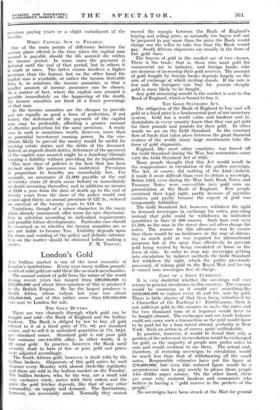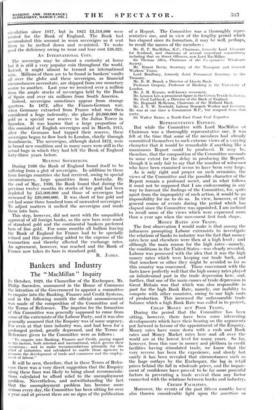London's Gold
rill: bullion market is one . Of the most 'romantic of London's institutions. Every year many million pounds! worth of solid gold are sold there like so much merchandise.
The annual output, of gold from the mines of the world (luring recent years, has ranged. from £80,000,000 to £85,000,000 and about_ three-quarters of this is produced in the British Empire. By far the largest producer is South Africa, whose output last year was about £45,000,000, and of this rather more than £36,000,000 was sent to London for sale.
THE GOLD BUYERS.
There are two channels through which gold can be bought and sold—the Bank of England and the bullion brokers. The Bank is obliged by, law to buy all gold offered to it at .a fixed price of 77s. 9d. per standard ounce, and to sell it in unlimited quantities at 77s. 1014. per standard ounce. Standard gold is not pure gold but contains one-twelfth alloy, in other words, it is 22 carat gold. In practice, however, the Bank until recently dealt in bars of fine or pure gold and prices were adjusted accordingly. _ The South African gold, however, is dealt with by the bullion brokers. Shipments of this gold arrive by mail steamer every 'Monday with almost clock-like regularity and these are sold in the bullion market on the Tuesday. The bullion brokers, who, by the way, are a small and ; very exclusive circle, arrive with their orders, and the . price the gold fetches depends, like that of any other commodity, on 'supply and demand. The fluctuations, however, are necessarily small. Normally they cannot. exceed the margin between the Bank of England's buying and selling price, as naturally the buyer will not be prepared to pay more than the price the Bank would Charge nor the seller to take less than the Bank would pay. South African shipments are usually in the form of fine ,gold bars. - • • - . ; The buyers of gold in the market are of two classes. There is the trade, that is, those who want gold for oommercial use in industry, -and foreign banks who are desirous of increasing their gold reserves. The amount of .gold bought by foreign hanks depends largely on the rate of exchange at which sterling stands. If the rate is low and the foreigner'-can 'buy -his pounds' cheaply gold is more likely to be bought.
Any gold remaining unsold in the market is sent to the Bank of England, vhich is bmind to buy it.
THE GOLD STANDARD ACT.
The obligation of the Bank, of England to buy and sell gold at a fixed price is a fundamental part of our monetary system. Gold has a world value and bankers and in- dustrialists in every country know that they can get gold for their pounds and pounds for their gold. In other words we are on the Gold Standard. In the constant flow of funds that takes place between the great -financial centres of the world, many large remittances take the form of gold shipments.
England, like most other countries, was forced- off the Gold Standard during the War, but restoration came with the Gold Standard Act of 1925.• Many people thought that this Act would result in the reappearance in circulation of the, golden sovereign. The Act, of course, did nothing of the kind ; indeed, it made it more difficult than .ever. to obtain a sovereign. Before 1925, even during the War, both Bank Notes and Treasury Notes were convertible into gold coin on presentation at the Bank of England. Few people exercised their legal right, partly because of patriotic motives and partly because the export of gold was temporarily forbidden. — The Gold Standard Act, however, withdrew the right to demand sovereigns in exchange for notes, providing instead that gold could be withdrawn in unlimited quantities in bars 'of 400 ounces. Such bars cost over £1,500, so the man in the street does not often change his notes. The reason for this alteration was to ensure that there would- be no hindrance in the way of obtain- ing as much gold as was required for international purposes but at the same time effectively to prevent gold being wasted by being circulated at home in the form of coin. In order to stop any sovereigns getting into circulation by indirect methods the Gold Standard Act withdrew the right, which the public previously possessed, of taking gold to the Royal Mint and having it coined into sovereigns free of charge.
COST OF A GOLD CURRENCY.
It is very doubtful whether the sovereign will ever return to general circulation in this country. The expense would be enormous as it would cost something like £250,000,000 to replace every £1 and 10s. note by gold. There is little chance of that item being introduced by a Chancellor of the Exchequ:r ! Furthermore, there is not sufficient gold in the -country to make the coins and the two thousand tons of it required would have to be bought abroad. The exchanges and our trade balance could not carry such a transaction so the gold would have to be paid for by a loan raised abroad, probably in New York. Such an action is, of course, quite unthinkable.
In practice, however, it- would be found that only a portion of the notes now in circulation would be exchanged for gold, as the majority of people now prefer notes to coin and would continue to use them. The actual cost, therefore, of restoring sovereigns to circulation would be much less than that of withdrawing all the small notes. Responsible estimates have put the figure at £70,000,000, but' even this reduced figure would be a preposterous sum to pay merely to please those people who dislike paper money. On, the other hand, there are some very eminent bankers and economists who believe in having a " gold reserve in the pockets of the people.' - No sovereigns have been struck at the Mint for general circulation since 1917,- but in 1925 £3,518,000 were minted for the Bank of England. The . Bank had accumulated. this -amount in worn sovereigns so it sent them to be melted down and re-.minted. To - make good the deficiency owing to wear and tear cost £38,321.
AN INTERNATIONAL COIN.
' The sovereign may. -be almost a curiosity at home but it is still a very popular coin throughout the world. Indeed, it might almost be termed an • international coin. Millions of them are to be found in bankers' vaults all over the globe and -these sovereigns, - as financial circumstances necessitate, are shipped from one monetary centre to another. Last year we received over a million from the ample stocks of sovereigns held by the Bank of Spain and over six millions from South America. Indeed, sovereigns sometimes appear from strange quarters. In 1872, after the Franco-German war, when Germany extracted from France what was then considered a huge indemnity, she placed £6;000,000 in gold as a special war reserve in the Julius Tower in Spandau. It was known that a large proportion of this consisted of English sovereigns and in March, 1915, after the Germans had tapped their reserve, these sovereigns began to flow back to London, chiefly through Scandinavia. The sovereigns; although dated 1872, were in brand new condition and in many cases were still in the actual bags in which they had left the Bank of England- forty-three years before.
MELTING SOVEREIGNS.
During 1930 the Bank of England found itself to be suffering from a -glut of sovereigns. In addition to those from foreign countries she had received, owing to special circumstances, large quantities from Australia. By the end of May, 1930, the Bank found that during the previous twelve months its stocks of bar gold had been depleted by £45,000,000 and thoe of sovereigns had increased by £39,000,000. It was short of bar gold and yet had some three hundred tons of unwanted sovereigns ! To adjust matters it melted the sovereigns and made them into bars. - This step, however, did not meet with the unqualified approval of all foreign banks, as the new bars were made of standard gold and the continental bankers preferred bars of fine gold. For some months all bullion leaving the Bank of England for 'France had to be specially refined and this- proceeding added-to the expense of the transaction and thereby affected the exchange rates. An agreement, however, was reached and the Bank of France now takes its bars in standard gold. R. JAMES.



























































 Previous page
Previous page